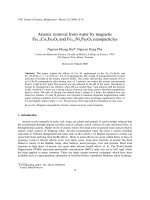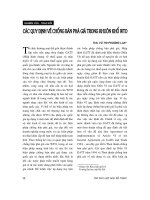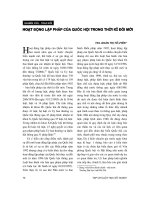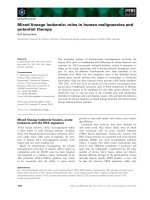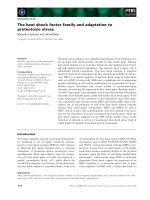Tài liệu Báo cáo " Bathymetry Mapping from Satellite Images for Ly Son Island, Quang Ngai Province " pdf
Bạn đang xem bản rút gọn của tài liệu. Xem và tải ngay bản đầy đủ của tài liệu tại đây (846.43 KB, 9 trang )
VNU JOURNAL OF SCIENCE, Earth sciences, T.xxIII, N
0
1, 2007
51
Bathymetry Mapping from Satellite Images
for Ly Son Island, Quang Ngai Province
Le Nhu Nga, Nguyen Thi Kim Nga
Institute of Mechanics
ABSTRACT. Up to present, in Vietnam, the traditional methods used to map marine
bathymetry are still very popular. These techniques have advantages of giving a high
accuracy but still show big disadvantages of taking too much time for the data acquisition
and processing and of being very expensive for the field works. Compensated to these cons
the remote sensing technique seems to be an ideal solution since the images covers almost
places on the earth with very high frequency (hours) of acquisition and served with a
reasonable price even some of them can be downloaded from the internet for free of charge.
In this paper, LANDSAT-7 (ETM+) optical-multispectral image, a space-born sensor, of Ly
Son Island area, Quang Ngai Province where the water is relatively clear was used, some
state-of-the-art methods of bathymetry mapping from optical-multispectral satellite images
were reviewed and tested, the data from marine chart was used for the model calibration
and quality assessment, and the discussion on the potential of these data sources for
mapping coastal areas of Vietnam was also conducted.
1. Introduction
The bathymetry is a branch of the oceanography that deals with the
measurement of the depths of the sea and studies its configuration and evolution over
time. It is an important data for activities on marine and coastal areas such as
engineering, navigation, researches, management and for hydro-dynamical applications
as input data.
In Vietnam, the echo-sounding technique with sonar equipment mounted on a
ship or boat has been being applied mostly for the bathymetry mapping (Dang, 1998).
In the world, the remote sensing technique has been being used for decades (IfM HH.
2005; Green et al., 2000) from different sensors such as optical, RADAR and LIDAR.
RADAR was used for global and regional scale while optical and LIDAR were used for
smaller area scale and for more detail and accuracy requirements. To coastal areas, for
a high accuracy data requirement, the Air-born Laser Bathymetry (ALB), LIDAR, is
the most favorite one. But this is a very costly data source. So, optical satellite images
such as SPOT, LANDSAT, Ikonos, QuickBird become very interested to researchers
now a day to find a low-cost mapping tool. These are the reasons this paper focused on
applying optical satellite images to estimate the water depth and to look at the
potential of this technique as a good mapping tool for coastal areas of Vietnam.
The LANDSAT-7 (ETM+) image and the marine chart of the Ly Son Island was
selected for the study because (i) the water of the area is relatively clear, (ii) the image
Le Nhu Nga, Nguyen Thi Kim Nga
52
was available to be downloaded from the internet, and (iii) the marine chart was
available with a reasonable price compared with unaffordable field work for the study.
2. Study area
Ly Son Island, Quang Ngai Province is located at the central of Vietnam and far
enough, about thirty kilometers, from the coastline to prevent much turbidity
influenced by sedimentation from the rivers and from the onshore waves. The area has
relatively clear water and stable and homogenous bottom property.
Figure 1. The study area of Ly Son Island and its location in Vietnam
3. Bathymetry mapping concept
This paper accepts the fundamental principle behind using remote sensing to
map bathymetry is that different wavelengths of light will penetrate water to varying
degrees. Intensity of the sun light
d
I will be attenuated by interaction with the water
column when passing through water length
p
as following:
pk
d
eII
−
=
0
, (1)
where
−
0
I
intensity of the incident light and
−
k
attenuation coefficient (Green et al.,
2000).
The longer wave length of light has a higher attenuation coefficient than shorter
ones. Therefore, the blue light can penetrate much deeper in the water than the red.
For clear water, the blue light can penetrate 30m deep, but red and near-infrared can
penetrate 5m and 0.5m only, respectively (Green et al., 2000). Fig. 3 illustrates this
idea. Therefore, on the same band, the higher DN (digital number, value of each pixel
of the image) value a pixel has the deeper water column is.
Bathymetry mapping from satellite images for Ly Son Island, Quang Ngai Province
53
The intensity of light can be quickly attenuated by interaction with suspended
materials such as sediments, phytoplankton and dissolved organic compounds. The
depth of attenuation of the blue light can be sub-meters only in turbidity water areas
(Green et al., 2000).
Currently, there are several methods studied to map bathymetry from the
optical-multispectral satellite images. To this study area, three most popular methods:
Benny and Dawson, 1983; Jupp, 1988; and Lyzenga, 1978 (Green et al., 2000) were
used to test.
Figure 2. Path of light from the sun to satellite (Benny, A.H, and Dawson, G.J., 1983)
Benny and Dawson (1983), and Jupp (1988) methods assumed that (i) light
attenuation is an exponential function of depth (equation 1); (ii) water quality
(attenuation coefficient) does not vary within an image; (iii) the color of the
substrate/seabed (reflective properties) is constant. Lyzenga (1978) method, like two
above methods, accepted the first two assumptions but did not the third one (Green et
al., 2000).
The second and third assumptions are weakness of these methods because a
satellite image normally covers a very large area and the water and sea-bed properties
vary, in some cases, very much.
4. Data sources and data processing
4.1. Satellite image
The LANDSAT-7 (ETM+) image (path 124, row 49) covering the area of Quang
Nam and Quang Ngai provinces was captured on 9
h
56 AM (Vietnam’s local time,
Seabed
Sea surface
From the sun
Sun elevation angle E
Atmospheric
scatter
Specular
reflection
Sun light angle E’
Water depth
d
To satellite
Le Nhu Nga, Nguyen Thi Kim Nga
54
GMT+7), July 13 2001. The image was downloaded for free of charge on the website of
the Earth Science Data Interface ( The image consists
of six bands (1-blue, 2-green, 3-red, 4-near infrared, 5-infrared, and 6- thermal
infrared) and has a 30m of spatial resolution. The quality of the image is quite good
with less noisy and less cloudy.
The study area was clipped out from the image with a dimension of 387 columns
and 239 rows (11.61×7.17km respectively). Then, the clipped image was enhanced for
visual interpretation and corrected geometry by using the marine chart.
The band 1, 2, 3 were used for the bathymetry estimation while band 4 used for
coastline extraction because the light could only penetrate few centimeters only on this
band.
(Band 1) (Band 2)
(Band 3) (Band 4)
Figure 3. Band 1-4 of the study area
4.2. Marine chart
The marine chart of the area at scale 1:100.000, published in 1980 by the
Vietnam’s Navy, was collected. A latter and larger scale one should have been used if it
was available.
The chart was scanned, geo-referenced and then used as reference data for the
image geometric correction and for the depth data extraction for the model calibration
and verification. 56 depth points were measured from the chart. Among them 30 were
LY SON ISLAND
LY SON ISLANDLY SON ISLAND
LY SON ISLAND
LY SON ISLAND
LY SON ISLANDLY SON ISLAND
LY SON ISLAND
LY SON ISLAND
LY SON ISLANDLY SON ISLAND
LY SON ISLAND
LY SON ISLAND
LY SON ISLANDLY SON ISLAND
LY SON ISLAND
Bathymetry mapping from satellite images for Ly Son Island, Quang Ngai Province
55
used for calibration and 26 for verification.
Figure 4. Digitized bathymetry of the marine chart.
The coastlines from the chart and from the satellite are relatively well-fitted
4.3. Tidal data
The tidal magnitude of the area at the time image captured on 9
h
56 AM (local
time), July 13, 2001 was referred to Dung Quat Cove station. Because the Dung Quat
Cove station was a subordinate station only, so its tide was calculated based on Da
Nang station, the closest reference station (Marine Hydrometeorological Centre, 2000).
The tidal data was used to synchronize the depth of water from the chart with
those from the image.
5. Result and accuracy assessment
In this paper, only bathymetry map calculated by using the Jupp’s method which
gave the best result.
The accuracy assessment was done by using 26 check points extracted from the
marine chart and separated with the 30 reference points. The highest and lowest
accuracies are of 0.13m and 4.14m (see Table 2 for more detail). The correlation
coefficient is of 0.76 (see Fig. 6 for more detail).
LY SON ISLAND
LY SON ISLANDLY SON ISLAND
LY SON ISLAND
Le Nhu Nga, Nguyen Thi Kim Nga
56
Figure 5. Map of calculated bathymetry of the study area
Table 2. List of 26 bathymetry points used to assess the accuracy of the model
No
X
(UTM)
Y
(UTM)
Check data
(m)
Estimated data
(m)
Error
(m)
1 299789 1703444 19.00 18.87 0.13
2 299974 1699184 18.00 18.18 0.18
3 297703 1703012 2.40 2.20 0.20
4 299377 1702633 6.20 6.41 0.21
5 294997 1701465 2.00 1.57 0.43
6 299098 1700018 2.10 1.63 0.47
7 300901 1699835 4.70 5.19 0.49
8 299967 1700526 3.30 2.43 0.87
9 293729 1701718 16.00 17.01 1.01
10 301709 1700926 8.80 7.53 1.27
11 294717 1702427 6.40 5.10 1.30
12 301350 1701626 6.20 7.79 1.59
13 296850 1702743 8.60 6.97 1.63
14 296612 1700250 3.70 2.05 1.65
15 295853 1702411 2.40 0.37 2.03
16 300018 1702464 8.30 6.15 2.15
17 297868 1699587 4.50 2.12 2.38
18 298469 1702830 4.80 2.16 2.64
19 295498 1700610 5.30 2.66 2.64
20 296645 1699367 21.00 18.36 2.64
21 293698 1702651 15.00 17.72 2.72
22 294180 1700397 18.00 15.23 2.77
23 294273 1701214 13.00 10.05 2.95
24 295489 1699332 19.00 15.88 3.12
25 302337 1699746 8.30 11.48 3.18
26 297032 1703133 23.00 18.86 4.14
Bathymetry mapping from satellite images for Ly Son Island, Quang Ngai Province
57
0
5
10
15
20
25
-5 5 15 25
Caculated data (m)
Check data (m)
Figure 6. Correlation between the check data and the calculated data
The correlation coefficient would be expected 0.8 or above for a good reference
data (Green et al., 2000). In this study, the reference data (the depths extracted from
an out-dated marine chart and the tidal data referred to other station) are not so
accurate; therefore, the result is acceptable.
6. Discussion and Conclusion
The result above doesn’t show accurate enough (some decimeters) for a published
marine chart; but to a rude map with less accuracy requirement purposes and in
situations that other techniques could not be done, especially for a low-cost solution the
optical-multispectral image is a suitable source.
Vietnam has a very long coastline, unfortunately, the Northern and Southern
parts are affected much by turbidity waters from the rivers therefore the technique is
not suitable; but in the middle part where the water is clear and seabed is relatively
homogeneous and covered mostly by sand, the technique can be applied; the technique
also is very suitable for islands such as Hoang Sa (Paracel) and Truong Sa (Spartley)
archipelagos where other techniques are very difficult and too expensive to be applied.
Like some other studies which recommended using the Jupp’s method, for this
study, the Jupp’s method also gave the best result but it is more complicated and
requires more time to calculate and more field work data to calibrate. So, for a single
band image, the Benny and Dawson method should be used because it is a simple one;
and the Lyzenga’s method could be used to improve the accuracy if the bottom
properties are known.
Le Nhu Nga, Nguyen Thi Kim Nga
58
Reference
[1] Dang Hung Vo (1998), Geodesy - marine chart of Vietnam. Proceeding of the 4
th
National
Marine Science and Technology Conference, Hanoi, November, 1998, pp. 23-34.
[2] Green, E. et al. (2000), Mapping bathymetry. In: Remote sensing handbook for tropical
coastal management (edited by A. J. Edwards), Coastal Management Sourcebook 3,
UNESCO Paris, pp. 219-233.
[3] IfM HH (2005), Bathymetric mapping (Internet address:
~wwwrs/activity_bathymetry.htm, 24 August, 2005).
[4] Marine Hydrometeorological Centre (2000). Tidal tables Vietnam 2001, Volume II, pp.
220.
VNU JOURNAL OF SCIENCE, Earth sciences, T.xxIII, N
0
1, 2007
51

